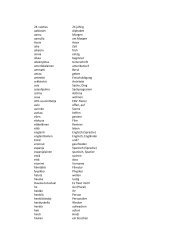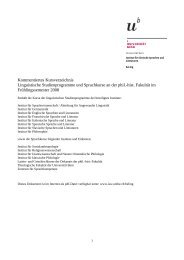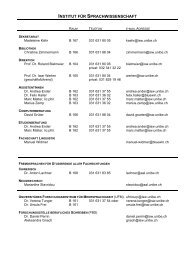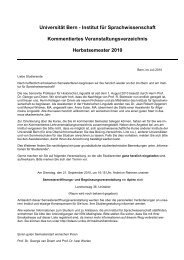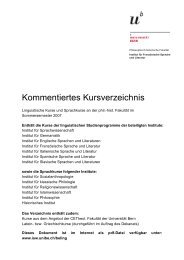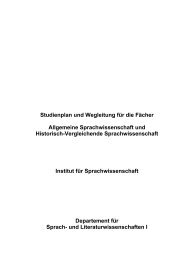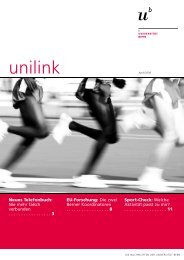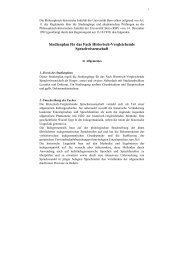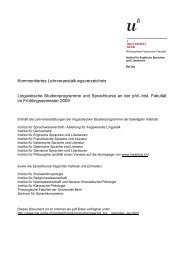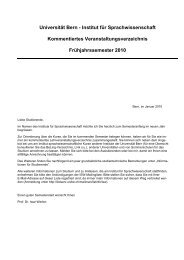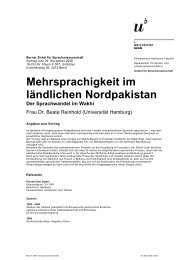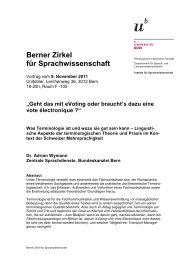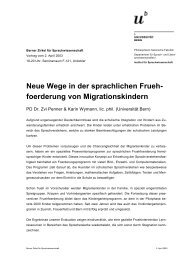The expression of modality in Korean - Institut für ...
The expression of modality in Korean - Institut für ...
The expression of modality in Korean - Institut für ...
You also want an ePaper? Increase the reach of your titles
YUMPU automatically turns print PDFs into web optimized ePapers that Google loves.
24<br />
<strong>of</strong> truth itself, i.e. „it is necessarily true/false that p“, but commented on by Palmer ( 2 1990, 6)<br />
that „alethic <strong>modality</strong> has been the ma<strong>in</strong> concern <strong>of</strong> logicians, but it has little place <strong>in</strong> ord<strong>in</strong>ary<br />
language“ (one example quoted by Conte (1995, 5) is Paul Watzlawik’s statement that one<br />
cannot not communicate), or anancastic <strong>modality</strong> (also <strong>in</strong>troduced by von Wright (1963, 10)<br />
and def<strong>in</strong>ed as „a statement to the effect that someth<strong>in</strong>g is (or is not) a necessary condition <strong>of</strong><br />
someth<strong>in</strong>g else“ (which also plays only a marg<strong>in</strong>al role at best <strong>in</strong> the l<strong>in</strong>guistic study <strong>of</strong><br />
<strong>modality</strong>), or are co<strong>in</strong>ed <strong>in</strong> studies on <strong>in</strong>dividual languages.<br />
Hav<strong>in</strong>g briefly discussed the basic characteristics <strong>of</strong> the most common types <strong>of</strong><br />
<strong>modality</strong>, I will conclude this general discussion at this po<strong>in</strong>t and proceed to the second<br />
pr<strong>in</strong>cipal prelim<strong>in</strong>ary <strong>of</strong> this work.<br />
1.2. <strong>Korean</strong><br />
<strong>The</strong> follow<strong>in</strong>g brief description is aimed at provid<strong>in</strong>g a basic notion <strong>of</strong> the most salient<br />
l<strong>in</strong>guistic features <strong>of</strong> the <strong>Korean</strong> language 20 <strong>in</strong> order to give a typological basis to this study <strong>of</strong><br />
<strong>modality</strong>.<br />
1.2.1. General language data<br />
<strong>The</strong> <strong>Korean</strong> language is spoken by approximately 70 million speakers 21 , <strong>in</strong>clud<strong>in</strong>g 42<br />
million <strong>in</strong> South Korea and 23 million <strong>in</strong> North Korea. Nearly 5 million or 7% <strong>of</strong> the native<br />
<strong>Korean</strong> speakers live outside the <strong>Korean</strong> pen<strong>in</strong>sula, spread out over some 100 countries,<br />
though most <strong>of</strong> the overseas population is concentrated <strong>in</strong> Ch<strong>in</strong>a (2,2 million), USA (1,3<br />
million and by far the fastest grow<strong>in</strong>g group), Japan (700’000) and the former USSR<br />
(500’000).<br />
<strong>The</strong> <strong>Korean</strong> language is, by comparison, relatively homogeneous with only m<strong>in</strong>or<br />
geographically def<strong>in</strong>ed dialectal differences (the <strong>Korean</strong> pen<strong>in</strong>sula is generally divided up <strong>in</strong>to<br />
seven dialectal zones, namely Hamgyong (North-East), P’yongan (North-West), Central<br />
20 This is, <strong>of</strong> course, no attempt to give a full-fledged portrait <strong>of</strong> the <strong>Korean</strong> language. Good shorter general<br />
descriptions are <strong>of</strong>fered by e.g. Kim (1987) or Campbell (1991).<br />
21 This and all follow<strong>in</strong>g figures <strong>in</strong> this paragraph are based on statistical data from the year 1992, taken from<br />
Sohn (1994) and <strong>Korean</strong> Overseas Information Service (1993).



